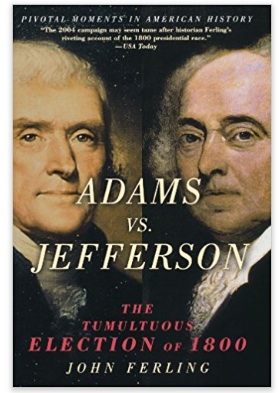We begin our look at the Federalist Era in New Nation Virginia with a national look at politics through the two Federalist presidents, George Washington and John Adams in “Presidency of George Washington” and “First Presidential Contest: 1796” for Adams’ election.
The development of political parties that were in Revolutionary theory the death knell of republics, and the counter-intuitive ascendancy of Thomas Jefferson to the presidency are described in “Revolution of 1800”, “Adams vs. Jefferson” and “The American Revolution of 1800”.
For book reviews of this historical period in other topics, see Revolution-Constitution-New Nation. General surveys of Virginia History can be found at Virginia History Surveys. Virginia history divided by time periods can be found at the webpage Books and Reviews.
The Presidency of George Washington

The Presidency of George Washington was written by Forrest McDonald in 1974, and is currently in print as a paperback. For McDonald, Washington was an indispensable figure of national unity. The book not only describes national issues, but also how they related to and interacted with state politics, especially in the development of the Democratic-Republican societies and the popular response to the Jay Treaty.
Centering on the economic basis of politics, McDonald illuminates the tensions between Washington cabinet, especially between Hamilton and Jefferson. He gives particular attention to the interaction of political and economic motivations in how the Washington administration met national problems and how it developed the presidential office during the two terms. Learn more to buy “Presidency of George Washington” here for your bookshelf.
The First Presidential Contest

The First Presidential Contest: 1796 and the Founding of American Democracy was written by Jeffrey L. Pasley in 2013. It tells the story of “history from the middle out”, how the popular press sought a replacement for George Washington for president, and in the process created a national presidential election in the Electoral College. Pasley focuses on the political images of Adams and Jefferson as forged by supporters and detractors among editors, government officials, congressmen and elector candidates.
The Election of 1796 was transitional, where elite-dominated politics began to give way to a democracy ideologically divided by liberalism and conservatism. Mid-level actors included Benjamin Franklin Bache, editor of the Philadelphia Aurora and Leven Powell, Federalist elector candidate from Loudoun County, Virginia.
Republicans favored public policy resulting from vigorous, rational public debate. Federalists believed that elections conferred decision making upon the chosen elite leaders. Learn more to buy “First Presidential Contest” here for your bookshelf.
American Revolution of 1800

The American Revolution of 1800 was written by Daniel Sisson in 1974 and reprinted in 2014 with Thom Hartman as a contributor. Instead of a focus on political party development, Sisson looks at the revolutionary extension of politics by Jefferson’s Republicans to incorporate an activated electorate based on the ideas and principles of individual liberty and opposition to monarchy in any form.
These innovations included activating state governments in opposition to the national government in legislative Resolves against the Alien and Sedition Acts, development of Democratic-Republican Societies in mass meetings, and the anti-Federalist administration Congressional Caucus.
Personal factions in the states among Jefferson, Adams, Hamilton, Charles C. Pinckney, and Burr were reflected in Congressional delegations and were determinative in the House selection of Jefferson over Burr. Learn more to buy “American Revolution of 1800” here for your bookshelf.
Adams vs. Jefferson

Adams vs. Jefferson: The Tumultuous Election of 1800 by John Ferling in 2004 reprinted in 2005. The Presidential Election of 1800 was the first national electoral crisis with the Electoral College vote thrown into the House of Representatives with each of the sixteen states casting one vote.
Ferling begins with political biographies of the principle candidates, John Adams running for re-election, Vice President Thomas Jefferson, New Yorker Aaron Burr and Georgian Charles C. Pinckney. He then describes the rise of national parties and their long campaigns for the 1800 election in the several states, the tie in the Electoral College and the 36 ballots to elect in the House of Representatives.
Both parties activated expanded electoral bases and though turnouts were increased, the margins were still relatively small. While the three-fifths rule tipped the aggregate Electoral College numbers in favor of the South, more importantly in states like Virginia, the vote was aggregated by a unit rule general ballot giving the state-wide winner all its elector votes. Learn more to buy “Adams vs. Jefferson” here for your bookshelf.
Revolution of 1800: Democracy, Race and the New Republic

The Revolution of 1800: Democracy, Race and the New Republic was edited by Peter S. Onuf and Jan Ellen Taylor in 2002. The essays are divided into three parts to examine how “revolutionary” was the presidential Revolution of 1800. The first part discusses political history, the second addresses social and cultural views, the third looks at international context. Changes were non-violent due to American attachment to their new Constitution and the Union.
Earlier developments in political parties were extended during Jefferson’s political presidency, but changes in newspaper politics and voter participation led to a qualitative difference in an expansion of the “psychology of democracy” for white males. Federalist reaction to Jeffersonian Deism led to Jefferson upholding Christianity, while women and blacks were explicitly excluded from Revolutionary Era roles.
While Jeffersonians continued developing the Federalist nation state built around administering a growing empire in the west in relations with foreign governments, Indians and the frontier, Jefferson supported democratic rebels neither in Canada nor in Haiti. Learn more to buy “Revolution of 1800: Democracy and Race” here for your bookshelf.
More Reviews
For book reviews of this historical period in other topics, see Revolution-Constitution-New Nation. General surveys of Virginia History can be found at Virginia History Surveys. Virginia history divided by time periods can be found at the webpage Books and Reviews.

